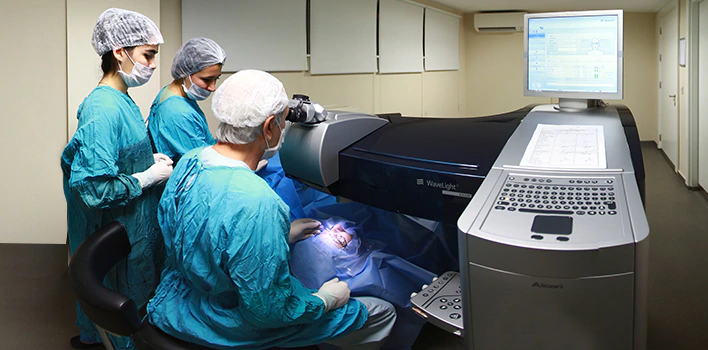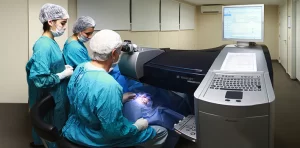Excimer Laser
The Excimer laser method is a widespread method used in the treatment of refractile defects such as myopia, hypermetropia and astigmatism.
Two techniques are currently used in Excimer Laser treatment:
1. Surface treatments (PRK-LASEK)
2. Treatments carried out in deeper areas (LASIK).
It is the treatment method which is to be preferred in refractile defects of a lower degree and where the thickness of the cornea is not sufficient for the Lasik method.
Surface Treatments
It is the application of the laser to the surface which appears as a result of the resection of the epithelium, which is the outer most layer of the cornea.
Contact lenses are worn for a few days after the procedure is completed in order for the surface to heal quicker and more easily, and for less discomfort. Vision is a little blurred until the healing of the surface has been completed (48-72 hours).
Treatments Carried out in Deeper Areas
Due to its advantages, such as the capability of it being used in high level refractile defects, the speed of visual recovery and the lower period of discomfort following the procedure (6-8 hours), it is the most widespread method currently used.
The lasik method consists of a thin layer on the surface of the cornea being lifted prior to the application of the laser, and the layer which has been lifted is replaced once the procedure has been completed.
Who is it applied to?
– Anyone over the age of 18. There is no upper age limit as long as long as cataracts or nuclear sclerosis, which is the beginning stage of cataracts, are not present.
– Individuals who have not experienced a change of more than 0.50 in the rating of their glasses within the last two years.
– Individuals who are found to have a suitable eye structure as a result of the examinations and observations carried out, and those who do not have any eye disease which will prevent the procedure (keratoconus, cataracts, glaucoma, diabetic retinopathy).
– Individuals with myopia up to 10.0 dioptry.
– Individuals with hypermetropia up to 6.00 dioptry.
– Individuals with astigmatism up to 6.00 dioptry.
– Individuals whose cornea thickness is sufficient.
– Individuals not suffering from rheumatism and diseases of the connective tissue
Prior to Laser Treatment
This is comprised of the examinations and observations required in order to be able to determine whether the eye is suitable for Excimer Laser treatment, and to plan the most appropriate and safe laser procedure for the eye.
It is at least as important a stage as the laser procedure itself.
Soft lenses must not be worn for 2 days, and hard and permeable lenses must not be worn for two weeks prior to treatment.
Laser Examination
The degree of visual acuity and refractile defect is determined. Eye pressure is measured. The front and rear sections of the eye are examined in detail.
Laser Observations
– The topographic (proclivity and elevation) map of the cornea, which is the transparent layer in the en section of the eye is prepared.
– The thickness of the cornea is measured using the pachymetric method. The thickness of the corneas is one of the most important parameters for determining the laser procedure which is to be applied.
– The dark and lit dimensions of the pupil are measures with a pupillometer.
– Wave front analysis is used to assess the irregularities which may be present in the transparent areas of the eye. The results of the examinations and observations are assessed together, and a decision is made as to whether the eye is suitable for the laser, and if it is, as to what procedure will be used.
The Treatment Stage
Excimer laser treatment takes a short time and is a procedure which is not difficult for the patient. The patient may eat before coming for the treatment. The only requirements are that no make-up is applied to the eyes and blood thinning medication such as aspirin is not taken.
When you enter the laser room you will be asked to lay on your back on the special laser bed and your eyes will be numbed using eye drops only. After covering your eyes with a sterile cover, your eyelids will be kept open with a special device in order to prevent you blinking.
The eyes will not be bandaged following the treatment.
Following the Treatment
A control examination is carried out approximately 30 minutes after the treatment is completed and the patient is then sent home.
With the lasik method the patient will experience 6-8 hours of burning and stinging sensations and watering of the eyes, a little time after the treatment. You should not drive or rub your eyes, and ensure that no water comes into contact with your eyes during the first day. Vision returns to close to normal on the day following the treatment.
These periods are close to 2-2.5 days when the PRK method is used.
Various eye drops are used for around 3 weeks following the treatment, in the lasik method. The PRK method requires use of drops for 6-8 weeks.
People today desire a more comfortable life. Many believe that contact lenses and glasses restrict them, and wish to be able to have good vision without their assistance. Due to big advances in technology, Excimer laser retractive surgery is the most widespread and most effective method which ensures that this target is reached. The number of applications of Excimer laser surgery in the world in the last 10 years has exceeded 50 million.
Extremely satisfactory results are obtained in the Excimer laser treatments applied by well-trained and experienced physicians with the aid of advanced technological devices.












